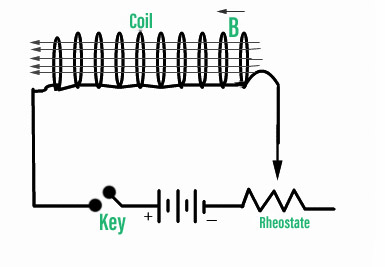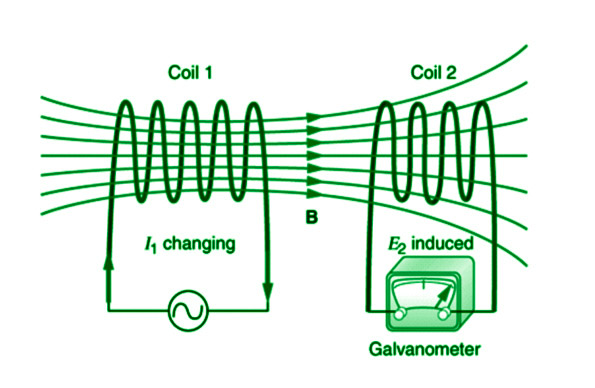Electromagnetic induction, often known as induction, is a process in which a conductor is placed in a certain position and the magnetic field varies or remains stationary as the conductor moves. A voltage or EMF (Electromotive Force) is created across the electrical conductor as a result of this.
Michael Faraday discovered this electromagnetic induction rule. He built up a leading wire similar to the diagram below, which he linked to a device that measured the voltage across the circuit. The voltage in the circuit is measured when a bar magnet passes through the device. The significance of this is that it is a method of creating electrical energy in a circuit by employing magnetic fields rather than batteries. The principle of electromagnetic induction is used by equipment such as generators, transformers, and motors.
Inductor and Inductance
A resistor is an electrical component that opposes and regulates the flow of electricity. Resistance is the ability of a conductor to resist current flow. While a capacitor is a device that briefly stores charge and energy, capacitance refers to a capacitor’s ability to store energy.
An inductor is nothing more than a coil. To make a coil, a conducting wire is tightly coiled. It will produce its constant magnetic field when a direct current is supplied through it. Instead, if we use an alternating current or a continually changing source, the current flowing through the coil will change. It will induce its emf in the opposite direction to the supply due to shifting magnetic flux. This is referred to as inductance. So, inductance refers to a conductor’s ability to resist changing current, but an inductor is an electrical device that does so.
Self-Inductance

The battery will produce a constant current in the coil if the rheostat resistance is kept constant. A continuous magnetic field will be induced inside the coil due to the constant current provided to it.
As the resistance of the rheostat is changed, the current flowing through the coil will also change. Since the current is changing, they will be a changing magnetic flux inside the coil. Due to the effect of changing magnetic flux, an emf will be induced inside this coil, trying to oppose the magnetic flux. Hence, due to the induced emf, the direction of current induced will be opposite to that of current supplied.
The current flowing in the coil determines the flux induced in the coil:
ϕ ∝ I
As a result, the flux-to-current ratio must be constant, as this will define the coil’s capacity to create magnetic flux in relation to the current provided. Self-inductance is the name for this constant (L).
L=ϕ/I
An inductor is the result of this process. If there are N turns on the coil, then
L=Nϕ/I
Nϕ=LI
Differentiating this equation in terms of time on both sides
d/dt (Nϕ)=d/dt (LI)
N dϕ/dt=L dI/dt
But, according to Faraday’s law of EMI, emf induced in a coil is,
ε=–N dϕ/dt
The negative sign indicates that the induced emf is in the opposite direction of the present rate of change.
ε=–L dI/dt
L=–ε /dI/dt
As a result, self-inductance may alternatively be defined as the emf induced per unit rate of current change within the coil minus the emf induced per unit rate of current change.
The SI unit of inductance is: Wb/A=Vs/A=Henry (H)
Magnetic Energy Stored in an Inductor
An inductor stores energy in the form of a magnetic field because it may induce its emf. Let us calculate the magnetic energy stored in an inductor using the following equation:
The rate of work done for a current I in the circuit may be represented as:
dW/dt=ε I
Substituting the following equation for the coil’s induced emf:
dW/dt=–L dI/dt I
dW=–LI dI
Integrating both sides of this equation:
∫dW=∫–LI dI
W=–1/2 LI2
Work done is the inverse of energy stored. So, if the inductor’s initial magnetic energy is zero, the energy stored in the inductor is:
U = 1/2 LI2
Mutual Inductance
Self-inductance is similar to mutual inductance. Instead, it consists of only two coils. One of them is given current, while the other is given emf.

Coil-1 is linked to a supply and a rheostat in the diagram, whereas coil-2 is connected to a galvanometer. Coil-1 will begin to flow with a fluctuating current. It will be induced with a shifting magnetic flux as a result of this. Because the coils are so near together, the changing magnetic flux will be connected to the other. Because the magnetic flux through coil-2 is constantly changing with respect to time, an emf opposing this magnetic flux will be induced in coil-2, causing a current to flow in the opposite direction of the provided current. As a consequence, we may claim that the current delivered in coil-1 causes the flux via coil-2.
ϕ2 ∝ I1
As a result, the flux through coil-2 and the current delivered in coil-1 will have a constant ratio. Mutual inductance in coil-2 owing to coil-1 is the name for this constant.
M21=ϕ2 / I1
We may define mutual inductance between two coils as the ratio of flux associated with one coil per unit current delivered in the other coil using the following equation.
ϕ2=M21 I1
Taking the preceding equation and differentiating it with regard to time
d/dt(ϕ2)=d/dt(M21 I1)
Using Faraday’s law of EMI
ε2=–M21 dI1/dt
M21=–ε2/dI1/dt
As a result, mutual inductance may alternatively be defined as the emf induced per unit rate of change in current in the inducing coil minus the emf induced per unit rate of change in current in the inducing coil.
Applications of Inductors
- Choking circuits mostly employ inductors (choke coil).
- In a transformer, the mutual inductance concept is applied.
- As the formula suggests, they are employed to store energy.
- To create alternating current, it’s used in an LC oscillator circuit.
- Used in power converters as well (ac-ac or dc-dc).
Sample Questions
Question 1: When a current of 2mA is supplied to a coil with 100 turns, a magnetic flux of magnitude 0.2Wb is linked with it. Find the self-inductance of this coil.
Answer:
Current supplied to the coil I=2mA
Number of turns in the coil (N)=100
Magnetic flux linked with the coil (ϕ)=0.2Wb
Self-inductance of a coil is given by the equation
L=Nϕ/I
Substituting the values
L=100×0.2/2
∴ L=10H
This coil has a self-inductance of 10H.
Question 2: Determine the energy stored in an inductor of inductance 100mH when a current of 0.2A is passed through it.
Answer:
The inductance of the inductor (L)=100mH
Current passed through it (I)=0.2A
Energy stored in an inductor is given by the equation
U=1/2LI2
Substituting the values
U=1/2×100×10–3×0.2×0.2
∴U=2mJ
The energy stored in this coil is 2mJ.
Question 3: What is the principle of mutual induction?
Answer:
Mutual induction is based on the electromagnetic induction concept. When one coil’s magnetic field connects to the other, the second coil generates its own emf. Mutual induction is the term for this procedure.
Question 4: Two long solenoids having length L and cross-sectional area A are placed in such a way that their axis coincide. Find the mutual inductance of this system.
Answer:
A long solenoid’s magnetic field is provided by:
B=μ0NI/L
As a result, if electricity is delivered through one of the solenoids, the magnetic flux within it will be connected to the other. As a result, this system’s mutual induction will be:
M=B1A/L
∴ M=μ0N1N2A/L
Question 5: What are the applications of inductors?
Answer:
- Inductors are commonly used in choking circuits (choke coil).
- The mutual inductance notion is used in transformers.
- They are used to store energy, as the formula says.
- It’s utilised in an LC oscillator circuit to generate alternating current.
- It’s also used in power converters (ac-ac or dc-dc).
Question 6: What is the use of mutual induction?
Answer:
Mutual induction is used in transformers, generators, motors, etc.
Question 7: What is the use of Inductance?
Answer:
Inductance is required to induce back emf and keep current flowing even after the switch is turned off.
Question 8: A long solenoid has 500 turns. When a current of 2 A is passed through it, the resulting magnetic flux linked with each turn of the solenoid is 4×10−3 Wb. find self-inductance.
Answer:
Φ=4×10−3 Wb/turn
N= Number of turns =500
I= Current flowing =2A
N×Φ=L×I
∴500×4×10−3
=L×2
∴L= 500×4×10−3/2
∴L=1H
∴ Self-inductance of solenoid is 1.0H
Question 9: A solenoid (air core) has 400 turns, is 20 cm long and has a cross-section of 4cm2. Then find the coefficient of self-induction.
Answer:
n=400turns ,l=20cm ,A=4cm2
L= 1⋅25×10−6Hm−1×400×400×4×100 / 100×100×20
=4×10−4H
Question 10: When a current of 4A between two coils changes to 12A in 0.5s in primary and induces an emf of 50mV in the secondary. Calculate the mutual inductance between the two coils.
Answer:
M= e2/ di2/dt
=(50 x 10-3) / (8/0.5)
=3.125 x 10-3 H
=3.125 mH
Like Article
Suggest improvement
Share your thoughts in the comments
Please Login to comment...